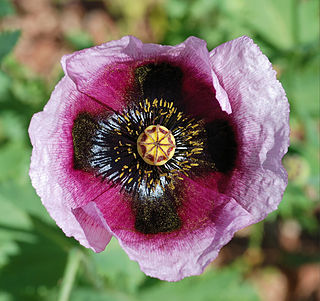
Papaver is a genus of 70–100 species of frost-tolerant annuals, biennials, and perennials native to temperate and cold regions of Eurasia, Africa and North America. It is the type genus of the poppy family, Papaveraceae.
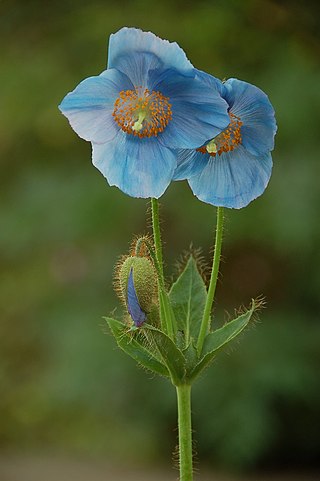
Meconopsis is a genus of flowering plants in the poppy family Papaveraceae. It was created by French botanist Viguier in 1814 for the species known by the common name Welsh poppy, which Carl Linnaeus had described as Papaver cambricum. The genus name means "poppy-like". Himalayan species discovered later were also placed in Meconopsis. In the 21st century, it was discovered that the Himalayan species were less closely related to the Welsh poppy, which has been restored to Papaver. All species now placed in Meconopsis are native to the Himalayas and surrounding regions. They have attractive, usually blue flowers.

Papaver cambricum, synonym Meconopsis cambrica, the Welsh poppy, is a perennial flowering plant in the poppy family Papaveraceae. It has yellow to orange flowers and is widely grown as a garden plant. It is a native of damp, rocky sites in upland areas of Western Europe from the British Isles to the Iberian Peninsula. It has been used since 2006 as the basis for the logo of the political party Plaid Cymru.
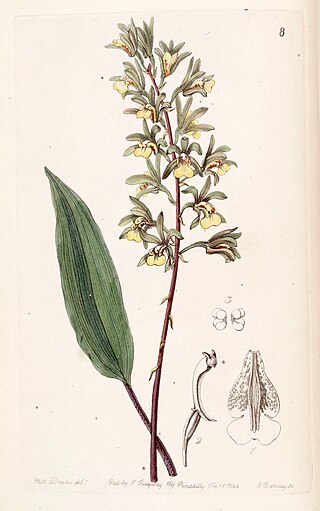
Tainia, commonly known as ribbon orchids or 带唇兰属 is a genus of about thirty species of evergreen, terrestrial orchids in the distributed from India, China, Japan, Southeast Asia to New Guinea, the Solomon Islands and Queensland.

Odontochilus is a small genus from the orchid family (Orchidaceae). These terrestrial, mycoparasitic orchids occur from China, Japan, the Himalayas, Southeast Asia, New Guinea and Melanesia. The genus is related to Gonatostylis, endemic to New Caledonia.
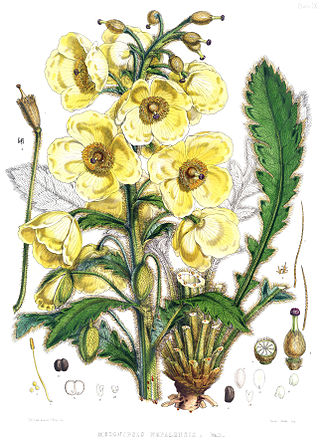
Meconopsis napaulensis, the Nepal poppy or satin poppy, is a plant of the family Papaveraceae. The plant contains beta-carbolines, which act as a psychedelic drug. However, its phytochemistry remains predominantly unstudied.

Pholidota, commonly known as rattlesnake orchids, is a genus of flowering plants from the orchid family, Orchidaceae. Plants in this genus are clump-forming epiphytes or lithophytes with pseudobulbs, each with a single large leaf and a large number of small, whitish flowers arranged in two ranks along a thin, wiry flowering stem that emerges from the top of the pseudobulb. There are about thirty five species native to areas from tropical and subtropical Asia to the southwestern Pacific.

Meconopsis grandis, the Himalayan blue poppy, is a species of flowering plant in the poppy family Papaveraceae, native to China (Yunnan), Bhutan, North East India and Nepal.

Thelasis, commonly known as fly orchids, is a genus of flowering plants from the orchid family, Orchidaceae. Plants in this genus are usually epiphytes, sometimes lithophytes or rarely terrestrials. Some species have pseudobulbs with up to three leaves, whilst others have several leaves in two ranks. A large number of small, white or greenish yellow flowers are borne on a thin, arching flowering stem. There are about thirty species, distributed from tropical and subtropical Asia to the southwest Pacific.

Micropera, commonly known as dismal orchids or 小囊兰属 is a genus of about twenty species of flowering plants from the orchid family, Orchidaceae. Plants in this genus are large epiphytes with thick roots, long, fibrous stems, linear leaves and whitish or yellow, non-resupinate flowers. The sepals and petals are similar to each other and the labellum is shoe-shaped or sac-like and has three lobes. It is found from Tibet to tropical Asia and the western Pacific Ocean.

Pteroceras is a genus of flowering plants from the orchid family, Orchidaceae. It is native to China, the Indian Subcontinent, and Southeast Asia.
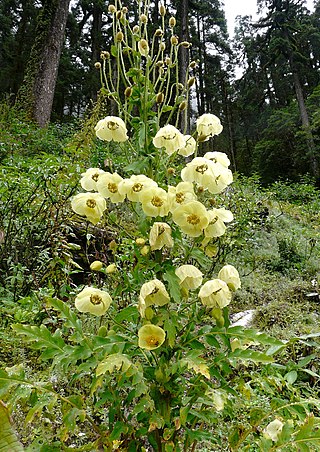
Meconopsis autumnalis, the Nepalese autumn poppy, is a yellow-flowered Himalayan poppy belonging to series Robustae, and is endemic to the Ganesh Himal range of central Nepal, where it was discovered in 2008 on a research expedition from the University of Aberdeen. In addition to several morphological features, the species is characterised by its late flowering period, which has more than likely resulted in a barrier to gene flow and subsequent evolutionary divergence from the closely related and sympatric species Meconopsis paniculata.

Meconopsis manasluensis is a red-flowered Himalayan poppy belonging to Meconopsis subg. Discogyne, which forms a natural grouping of 6 or 7 species within the genus all characterised by a stylar disc surmounting the ovary. As reflected by the species etymology, M. manasluensis is endemic to the vicinity of the Manaslu Himal of Gorkha district, central Nepal, where it grows at high elevation and so far remains known only from its type collection locality.

Meconopsis horridula, the prickly blue poppy, is a flowering plant from the family Papaveraceae. It is an endangered species that grows in high altitudes. The height of the plant varies from 20 cm to 1m. It is a monocarpic, dicot plant.
Meconopsis lancifolia is a plant species in the genus Meconopsis, in the family Papaveraceae. M. lancifolia is monocarpic, meaning that it flowers only once before dying.
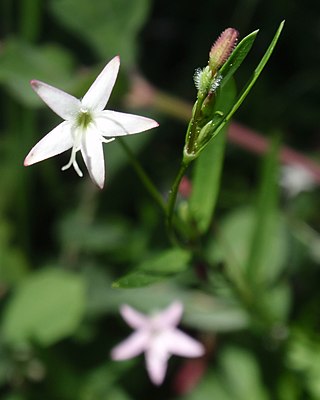
Kelloggia is a plant genus in the bedstraw and madder family, Rubiaceae. Its two species have a discontinuous distribution; one species is native to Bhutan and China, the other to the western United States.

Meconopsis gakyidiana is a species of blue poppy native to Eastern Bhutan, Western Arunachal Pradesh of India and Southern Xizang of China. It is the national flower of Bhutan.
Vaccinium sikkimense is a species of flowering plant in the family Ericaceae, native to South-Central China, East Himalaya, Myanmar, Nepal and Tibet. It was first described by Charles Baron Clarke in 1882. It may only be a dwarf alpine form of Vaccinium glaucoalbum.
Cathcartia is a small genus of flowering plants in the family Papaveraceae, native to China, Nepal, the eastern Himalayas, and northern Myanmar. Chloroplast DNA evidence supports a split of Cathcartia from the blue poppy genus Meconopsis in an effort to resolve longstanding taxonomic difficulties in the Himalayan poppies.

Oreomecon is a genus in the poppy family Papaveraceae. It was established in 2022 for what was previously treated as Papaver sect. Meconella in order to ensure that the genus Papaver was monophyletic. As of June 2023, names in the genus Oreomecon had only been published for better known and phylogenetically understood species present in Europe, either as natives or aliens.
















